
All categories
Featured selections
Trade Assurance
Buyer Central
Help Center
Get the app
Become a supplier

(5992 products available)
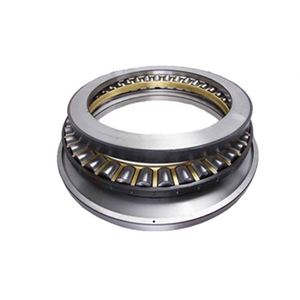

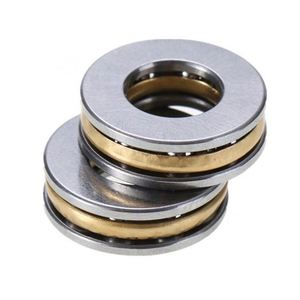
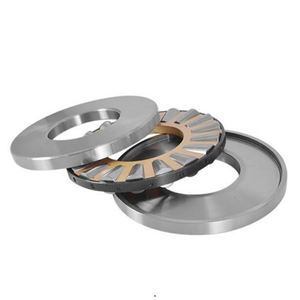














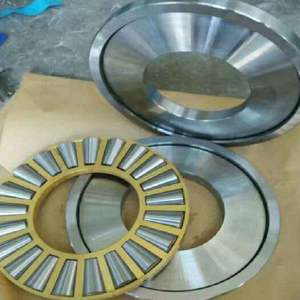








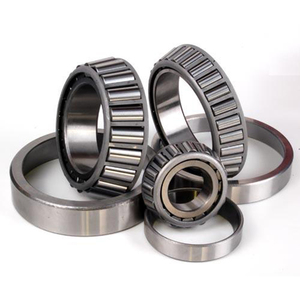





There're some types of taper thrust roller bearings that perform distinct purposes. Here's a rundown:
Single-row taper thrust ball bearing
This bearing consists of an outer ring, a cup, cone, and a taper angle shaft. It permits one direction axial displacement, while the tapered raceways and rolling elements generate concentrated contact that improves load-carrying capacity and minimizes friction for optimal stability and motion accuracy. It's applicable in automotive and agricultural equipment, accommodating moderate axial loads in individual alignment systems.
Double-row tapered thrust ball bearing
The required bearing features two rows of tapered rollers angled toward a common axis, allowing it to accommodate both directional axial loads. The design offers increased load-carrying capacity and improved rigidity compared to single-row variants. It has applications in heavy machinery, mining equipment, and marine drives, requiring support for combined radial and thrust loads while sustaining alignment under harsh operating conditions.
Adjustable tapered thrust ball bearing
This bearing permits fine adjustment of clearances, allowing for better control over axial and radial tolerances. The design typically consists of a tapered inner and outer race and tapered rollers. It finds extensive use in precision machinery, aerospace components, and heavy industrial equipment, where fine control over bearing clearances is critical to ensure optimal performance under varying load conditions.
Combined tapered thrust ball bearing
This type integrates axial and radial functions into a compact form. It consists of a tapered thrust inner and outer race and rollers, coupled with a radial inward set ball. The design supports combined axial and radial loads efficiently. It's suitable for space-constrained applications in the automotive and aerospace industries, where balanced multi-directional load-carrying capabilities are needed without sacrificing form factor.
High-capacity taper ball bearing
This specialized bearing for demanding applications features larger rollers and an optimized raceway profile to enhance load-carrying capacity. The extended raceways provide better distribution of loads, reducing stress on the bearing elements. It's ideal for heavy-duty applications in oil and gas exploration equipment, mining machinery, and structural welding in cranes and hoists, where bearings endure extreme loads and adverse environments.
Automotive industry
Tapered thrust bearings are installed in differentials, transmission, and wheel assemblies. Their ability to maintain precise shaft alignment under axial and radial loads makes them critical for smooth gear operation and supporting heavy loads, especially in truck and SUV applications. Thrust bearings reduce friction and wear while improving load distribution, enhancing the lifespan of components, and improving overall vehicle performance and reliability.
Aerospace engineering
In aerospace applications, tapered ball bearings are used in flight control systems and landing gear. These bearings are required to sustain elevated precision, reliability, and minimal weight under dynamic loads and extreme conditions. Tapered thrust bearings aid in the smooth operation of mechanical systems, ensuring accurate motion transfer essential in avionics and landing gear systems. Their ability to cope with both axial and radial loads enables effective support for heavy structures while maintaining alignment in mobile components. In addition, the low friction characteristics of the bearings contribute to energy efficiency, a critical factor in flight operation and safety.
Heavy machinery and construction equipment
These thrust bearings are used in the thrust bearings found in excavators, loaders, and trucks. They support substantial axial and radial loads, offering durability and reliability in demanding circumstances. The role of tapered thrust bearings in heavy machinery is to improve load-carrying capacity and distribute it more evenly, hence extending the life of the parts. The smooth operation of gears will be achieved by their guidance, contributing to the effectiveness and productivity of construction work.
Renewable energy systems
Tapered thrust bearings manage the axial loads in wind turbine rotor shafts and gearbox systems. In wind turbine applications, they are in the critical components under dynamic loads from changing wind conditions. The bearings provide effective load transmission while minimizing friction and wear. In wind turbines, their role is to ensure reliable operation under varying environmental conditions, sustain the turbine's dynamic operating loads, and contribute to its efficiency and long-term functioning. This makes them crucial for both reliability and maintenance in energy generation on a large scale.
Mining and oil exploration
Mining and oil exploration employ tapered thrust bearings in rotating equipment, drill bits, and downhole tools. These are some of the most extreme applications for thrust bearings. They support significant axial loads and harsh operating conditions. The thrust bearings have been made ruggedly to endure shock loads and ensure that drilling operations transmit forces smoothly, enhancing the drill bit's effectiveness. This minimizes wear on both the bearings and other components, resulting in greater operational efficiency and less downtime. In these applications, the ability to function reliably under extreme conditions cannot be overstated.
Inner and outer diameter sizes (mm)
Common inner diameters are 30, 35, 50, and 130 millimeters, while common outer diameters are 60, 65, 90, and 180 millimeters. These sizes cater to various machinery and automotive applications.
Width (mm)
They typically range from 10 to 30 millimeters in industrial and mining applications, where space constraints are critical in aerospace or compact equipment.
Dynamic and static load rating (kN)
The dynamic load rating commonly ranges from 15 to 80 kilonewtons for light industrial and automotive applications and up to 500 kilonewtons for heavy machinery in mining and oil drilling.
Material
Tapered thrust bearings have steel bearing races and rollers and chrome alloys for strength, hardness, and corrosion resistance. Some are stainless or ceramic for specialized applications like food processing and biomedical devices.
Seal type
The common seal types include metal dust shields and rubber seals for an extended lifespan in hazardous environments. These seals effectively prevent contaminants such as dirt, dust, and moisture ingress into the bearing while retaining lubrication selectively.
Optimized raceway geometry
This reduces stress concentration, distributes the load more evenly, and enhances load-carrying capacity and durability. The combined effect is that raceways improve fatigue resistance and extend the lifespan of the bearing.
Precise roller shape
The tapered rollers have a larger contact area to distribute the load more efficiently and reduce the risk of deformation under heavy loads. This ensures the bearing maintains its operational integrity even under extreme conditions.
Heat treatment
The rollers and races undergo heat treatment to achieve superior hardness and fatigue resistance, increasing the overall lifespan of the bearing in high-stress environments.
Clearance options
Standard clearance, C3, and C4 clearness allow for the thermal expansion of components to ensure optimal performance in various temperature conditions. Standard clearance is for normal operating conditions, while C3 and C4 are for extended loads and temperatures.
Easy installation and adjustment
The tapered design simplifies initial setups and subsequent adjustments, reducing installation time and ensuring optimal bearing performance throughout its service life.
Load capacity
When selecting tapered thrust roller bearings, consider the bearing's dynamic and static load ratings to ensure it can handle the axial and radial loads of the intended application. For example, high-capacity bearings are ideal for cranes and mining equipment under heavy and dynamic loads.
Shaft and housing size
The bearing inner diameter should match the shaft size, while the outer diameter should fit the equipment housing. Proper size ensures correct fit and minimizes misalignment. Standard sizes are suitable for general applications, while custom sizes offer special solutions for specific challenges where space constraints may be involved.
Speed rating
Select a bearing with an appropriate speed rating for the application. Higher-speed applications such as turbines and electric motors require bearings that can withstand increased rotational speeds with minimal friction, heating, and wear. Some have special cage designs and lubrication for effective performance at high speeds.
Material and lubrication
Pick a bearing made from high-quality alloy or stainless steel, which offers great resistance to wear, corrosion, and fatigue in harsh environments. For instance, lubrication options include grease or oil; select a bearing for sealed the bearing to retain lubricant and prevent contaminant ingress for applications like food processing or heavy outdoor machinery.
Environmental conditions
Consider the surrounding conditions in which the bearing will operate. Extreme temperature, humidity, and exposure to pollutants such as dust, water, or chemicals require special treatment. Choose a bearing with seals, shields, and corrosion-resistant materials to ensure optimal performance and longevity in these challenging environments.
Precision and tolerance
Define the required tolerance and bearing running precision. High-precision bearings are critical for aerospace or robotic applications, where alignment and movement must be accurate. General-purpose bearings have lower tolerances and are suitable for heavy-duty or construction.
Maintenance begins with periodic lubrication replenishment using grease or oil specific to the application. Monitor operating conditions like temperature, load, and exposure to contaminants, then inspect regularly for wear, corrosion, or misalignment, particularly in industrial or heavy-duty environments. A timely replacement of worn components is recommended to avoid bearing failure and ensure operational efficiency.
The bearing's operating environment, including temperature, humidity, and exposure to pollutants, the quality and type of lubrication used, the materials and sealing design, and the precision of the bearing installation, all play vital roles. The absence of proper alignment and excessive misalignment load may lead to premature wear, hence shortening the lifespan.
The roller bearings are usable as replacements only when the bearings in question are of the same size and type and share identical load ratings and clearance specifications. However, bearing components can be unsuitable for one another, even if they belong to the same family, especially if they belong to different manufacturers. Hence, there must be a proper match to avoid mechanical failure when components fail to work together correctly.
Improper installation can lead to a series of mechanical problems. These include excessive wear due to misalignment, leading to uneven load distribution and potential races and roller damage. Too tight or loose fitting can cause overheating due to increased friction, which will be accompanied by early failure. There may also be a complete bearing malfunction caused by misalignment.
Commonly fitted seals include metal dust shields and rubber seals. Metal dust shields are tough protective barriers against dust, dirt, and other large contaminants, ideally suited for heavy industrial environments. At the same time, the rubber seal is a flexible, resilient barrier that effectively traps moisture and smaller particles while retaining lubrication, thus protecting the bearing under varying temperature conditions.